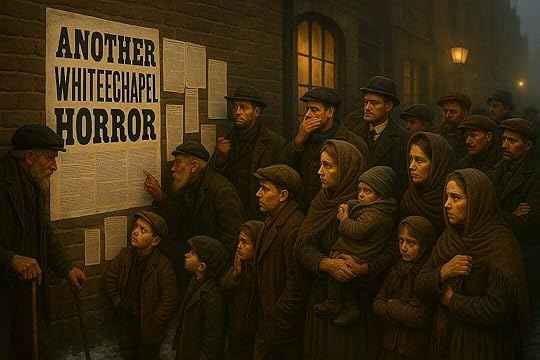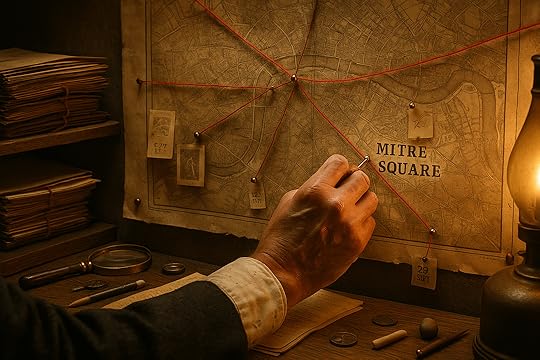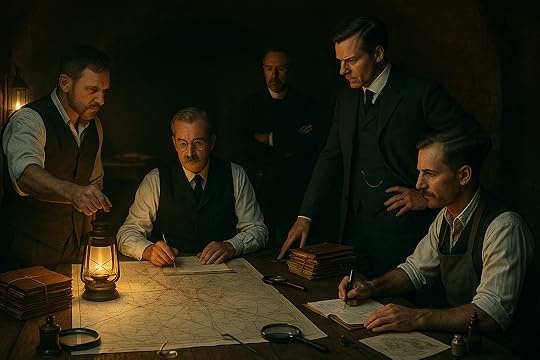The Case That Wouldn't Die
How Scotland Yard kept hunting Jack the Ripper long after history closed the file

The original case terrified London and spawned a century of theories, suspects, and lurid legend. Now, with No Rest for the Damned, the hunt for Jack the Ripper continues — not in waxwork myth, but in blood, ink, and procedural grit. Fancy another walk through Whitechapel’s fog?
Words: By Gerard Edmund Snook
Crowds have always been unsettling. In 1888, they pressed into Whitechapel’s alleys, desperate for news, for blood, for answers. Newspapers sold terror by the column-inch, and Scotland Yard, exhausted and humiliated, boxed shadows with little more than witness statements and gut instinct. A case thought finished with Mary Jane Kelly in November of that year calcified into one of history’s great unsolved mysteries.
No Rest for the Damned dares to prise the case file back open. It imagines what Scotland Yard’s men — Abberline, Anderson, Swanson, Bond — might have uncovered had they pursued the trail beyond the so-called “Canonical Five.”“This was never about invention for its own sake,” says author Kevin Morris. “It was about asking: what if the investigation hadn’t stopped? What if the paper trail we lost was never really the end?”
From the opening pages, Inspector Frederick Abberline’s voice is not one of legend, but of fatigue: “That was the Ripper case, built on whispers, not proof, more questions than answers. We chased ghosts through the streets of London, following leads that led nowhere.”
This is a world where evidence piles high, but answers remain scarce. Hundreds of suspects. Thousands of tips. Dozens arrested, none convicted. The book takes the infamous Whitechapel murders and spins them forward: not as conspiracy, but as continuity.
Just as Conan Doyle reshaped crime fiction by grounding Sherlock Holmes in method and deduction rather than penny-dreadful sensationalism, Morris strips the Ripper story of melodrama. What’s left is a procedural with gothic weight — detectives in draughty offices, surgeons bent over cold slabs, Home Office men debating whether truth itself is too dangerous for public consumption.
Bond, the surgeon, voices the dread plainly: “The corpse never lies. The trouble is, it tells us more than we care to know.”
The cast of investigators reads like a roster of haunted men. Assistant Commissioner Anderson, forever straddling politics and policing, warns: “If we did not stop him, the mob would. And then London would not forgive us for centuries.”

Chief Inspector Swanson, the meticulous clerk of horrors, unfurls the case like a map of dread. “At 1:44 a.m. on the same night, Catherine Eddowes, aged forty-six, was discovered less than a mile away in the southwest corner of Mitre Square. This time, the body bore the hallmarks of our man. Her throat was cut, and her abdomen mutilated, but with a notable addition. Her face, too, had been slashed. And,” he paused, tapping another pin on the board, “her left kidney was missing.”
His summaries become the skeleton of the story, a grim cadence marking each body found.
Assistant Chief Constable Macnaghten, new blood with aristocratic polish, is sketched with scepticism. Confronted with an eyewitness report, he scoffs: “So it was night, the man had a dusky appearance, and he wore black. How much weight do we place on that description?”
These voices — sometimes weary, sometimes cutting — create a texture absent from most retellings. They’re not just hunting a phantom; they’re wrestling with bureaucracy, bias, and their own limitations.
If the police are driven by duty, the politicians are driven by fear. Home Secretary Henry Matthews delivers perhaps the book’s most chilling directive: “This… Ripper business has gone on long enough. Who’s to say the next killing won’t spark a riot that tears the city apart? … The case must be brought to a discreet close.”
It’s a reminder that murder investigations don’t happen in a vacuum. Behind the fog lies a state worried less about bodies in the street than about revolution in the air.
Abberline, caught between conscience and command, admits: “For me, that was the hardest part to reconcile. I had no one in this world I wished to betray less than my dear wife, Emma. But there was no comfort in conscience, no shield to raise against the gnawing truth.”
Make no mistake: No Rest for the Damned is a whodunnit. Every strand of testimony, every chalk scrawl on a wall, every organ missing from a body is pressed for meaning. But it is also a “what next” story — a study of how London holds its breath, how Yard men push forward when the truth refuses to yield.

The subterranean chambers beneath Whitehall, converted into secret offices, echo with frustration and fragile hope. Swanson pins a threadbare map with trembling hands; Macnaghten seizes on theories like a man desperate for purchase; Bond mutters about the crude hands of a killer who knows just enough to terrify.
At one point, Abberline’s narration strips the case bare: “We were right back where we started. How many more women? How many more nights?”
Why does this story matter now? Because myths fade, but dread lingers. The case of Jack the Ripper is not just a mystery unsolved; it is a question of how societies confront the unknowable. Morris places readers not with armchair theorists but with the men who carried the weight of failure on their shoulders.
“This isn’t about solving the Ripper alone,” Morris says. “It’s about the reckoning. What happens to London, to the Yard, to men like Abberline when the killings don’t stop where history tells us they did?”
The answer lies in the dark corridors of Whitechapel, in the fogged glass of Scotland Yard, and in the uneasy knowledge that some phantoms never leave.
The case of Jack the Ripper, it seems, has no rest. And neither do we.
ABOUT NO REST FOR THE DAMNED BOOK SERIES:
No Rest for the Damned (formerly published as The Ripper Lives) is a gripping serialized Victorian crime thriller told across three heart-pounding volumes, collecting all 10 original books in one sweeping saga. Each volume delivers a fast-paced, immersive read—but taken together, the full series spans over 600 pages of relentless suspense, chilling twists, and richly atmospheric Victorian mystery.
All three volumes are available now on Kindle Unlimited. Step into the shadows—the hunt is far from over.
Website: https://Linktr.ee/TrilogiesofTerror

The original case terrified London and spawned a century of theories, suspects, and lurid legend. Now, with No Rest for the Damned, the hunt for Jack the Ripper continues — not in waxwork myth, but in blood, ink, and procedural grit. Fancy another walk through Whitechapel’s fog?
Words: By Gerard Edmund Snook
Crowds have always been unsettling. In 1888, they pressed into Whitechapel’s alleys, desperate for news, for blood, for answers. Newspapers sold terror by the column-inch, and Scotland Yard, exhausted and humiliated, boxed shadows with little more than witness statements and gut instinct. A case thought finished with Mary Jane Kelly in November of that year calcified into one of history’s great unsolved mysteries.
No Rest for the Damned dares to prise the case file back open. It imagines what Scotland Yard’s men — Abberline, Anderson, Swanson, Bond — might have uncovered had they pursued the trail beyond the so-called “Canonical Five.”“This was never about invention for its own sake,” says author Kevin Morris. “It was about asking: what if the investigation hadn’t stopped? What if the paper trail we lost was never really the end?”
From the opening pages, Inspector Frederick Abberline’s voice is not one of legend, but of fatigue: “That was the Ripper case, built on whispers, not proof, more questions than answers. We chased ghosts through the streets of London, following leads that led nowhere.”
This is a world where evidence piles high, but answers remain scarce. Hundreds of suspects. Thousands of tips. Dozens arrested, none convicted. The book takes the infamous Whitechapel murders and spins them forward: not as conspiracy, but as continuity.
Just as Conan Doyle reshaped crime fiction by grounding Sherlock Holmes in method and deduction rather than penny-dreadful sensationalism, Morris strips the Ripper story of melodrama. What’s left is a procedural with gothic weight — detectives in draughty offices, surgeons bent over cold slabs, Home Office men debating whether truth itself is too dangerous for public consumption.
Bond, the surgeon, voices the dread plainly: “The corpse never lies. The trouble is, it tells us more than we care to know.”
The cast of investigators reads like a roster of haunted men. Assistant Commissioner Anderson, forever straddling politics and policing, warns: “If we did not stop him, the mob would. And then London would not forgive us for centuries.”

Chief Inspector Swanson, the meticulous clerk of horrors, unfurls the case like a map of dread. “At 1:44 a.m. on the same night, Catherine Eddowes, aged forty-six, was discovered less than a mile away in the southwest corner of Mitre Square. This time, the body bore the hallmarks of our man. Her throat was cut, and her abdomen mutilated, but with a notable addition. Her face, too, had been slashed. And,” he paused, tapping another pin on the board, “her left kidney was missing.”
His summaries become the skeleton of the story, a grim cadence marking each body found.
Assistant Chief Constable Macnaghten, new blood with aristocratic polish, is sketched with scepticism. Confronted with an eyewitness report, he scoffs: “So it was night, the man had a dusky appearance, and he wore black. How much weight do we place on that description?”
These voices — sometimes weary, sometimes cutting — create a texture absent from most retellings. They’re not just hunting a phantom; they’re wrestling with bureaucracy, bias, and their own limitations.
If the police are driven by duty, the politicians are driven by fear. Home Secretary Henry Matthews delivers perhaps the book’s most chilling directive: “This… Ripper business has gone on long enough. Who’s to say the next killing won’t spark a riot that tears the city apart? … The case must be brought to a discreet close.”
It’s a reminder that murder investigations don’t happen in a vacuum. Behind the fog lies a state worried less about bodies in the street than about revolution in the air.
Abberline, caught between conscience and command, admits: “For me, that was the hardest part to reconcile. I had no one in this world I wished to betray less than my dear wife, Emma. But there was no comfort in conscience, no shield to raise against the gnawing truth.”
Make no mistake: No Rest for the Damned is a whodunnit. Every strand of testimony, every chalk scrawl on a wall, every organ missing from a body is pressed for meaning. But it is also a “what next” story — a study of how London holds its breath, how Yard men push forward when the truth refuses to yield.

The subterranean chambers beneath Whitehall, converted into secret offices, echo with frustration and fragile hope. Swanson pins a threadbare map with trembling hands; Macnaghten seizes on theories like a man desperate for purchase; Bond mutters about the crude hands of a killer who knows just enough to terrify.
At one point, Abberline’s narration strips the case bare: “We were right back where we started. How many more women? How many more nights?”
Why does this story matter now? Because myths fade, but dread lingers. The case of Jack the Ripper is not just a mystery unsolved; it is a question of how societies confront the unknowable. Morris places readers not with armchair theorists but with the men who carried the weight of failure on their shoulders.
“This isn’t about solving the Ripper alone,” Morris says. “It’s about the reckoning. What happens to London, to the Yard, to men like Abberline when the killings don’t stop where history tells us they did?”
The answer lies in the dark corridors of Whitechapel, in the fogged glass of Scotland Yard, and in the uneasy knowledge that some phantoms never leave.
The case of Jack the Ripper, it seems, has no rest. And neither do we.
ABOUT NO REST FOR THE DAMNED BOOK SERIES:
No Rest for the Damned (formerly published as The Ripper Lives) is a gripping serialized Victorian crime thriller told across three heart-pounding volumes, collecting all 10 original books in one sweeping saga. Each volume delivers a fast-paced, immersive read—but taken together, the full series spans over 600 pages of relentless suspense, chilling twists, and richly atmospheric Victorian mystery.
All three volumes are available now on Kindle Unlimited. Step into the shadows—the hunt is far from over.
Website: https://Linktr.ee/TrilogiesofTerror
Published on October 01, 2025 09:17
•
Tags:
gothic-detective-mystery, historical-murder-mystery, kindle-books, kindle-unlimited, scotland-yard-police-procedural, victorian-crime-thriller, victorian-gothic-murder-mystery, whitechapel-murder-mystery
No comments have been added yet.



